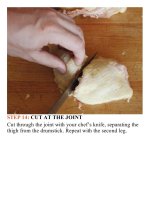The food lab better home cooking through science ( PDFDrive ) 1068
Bạn đang xem bản rút gọn của tài liệu. Xem và tải ngay bản đầy đủ của tài liệu tại đây (132.96 KB, 2 trang )
“vegetable” oil (usually a mix of soybean and corn oil),
grapeseedoil,andbaconfat.
I immediately noticed a direct correlation between the
level of saturated fat in a given cooking medium and how
crisp the chicken got. Chicken cooked in highly saturated
lard (40 percent saturated fat), shortening (31 percent),
bacon fat (40 percent), or palm oil (81 percent) was by far
the crunchiest. This seems like a good thing—until you
actuallyletitcoolabitandeatit.Becausethosefatsareall
close to solid at body temperature, they leave your mouth
with an unappetizing waxy coating.With lighter foods like
tempura-style vegetables or fish, this coating is especially
noticeable.
On the opposite end of the spectrum, chicken fried in
highly unsaturated fats like grapeseed (10–12 percent
saturated fat), olive (13 percent), corn (13 percent),
sunflower (10 percent), avocado (12 percent), or vegetable
(around13percent)oilsufferedfromtheoppositeproblem:
the chicken simply didn’t crisp up as well. The winner?
Peanutoil,withitsmoderatelyhighlevelofsaturatedfat(17
percent) and clean, neutral flavor. The chicken fried up
cleanandcrisp,withoutanyofthemouth-coatingwaxiness
ofthehighlysaturatedfats.It’smyfatofchoiceforalmost
allfryingprojects,notjustchicken.
SATURATEDVERSUS
UNSATURATEDFAT
W
e hear the terms “saturated fat” and
“unsaturated fat” thrown about often, but what do
they really mean, and how do they affect your
cooking?
Like most organic compounds, fats are pretty
complicatedmolecules.They’renaturallykinkedand
wound up, but if you were to straighten one out, it
would resemble the letter E, with a molecule of
glycerolformingthespineandlongchainsofcarbon
atoms called “fatty acids” forming the three arms.
It’stheexactmakeupofthesearmsthatdetermines
whetherornotafatissaturated.
A carbon atom can form four bonds with other
atoms. In saturated fats, every carbon atom in the
chain is bonded to two hydrogen atoms, along with
the carbon atom preceding it and following it.† In
unsaturatedfats,oneormoreofthecarbonatomsis
bound only to a single hydrogen. In place of the
missing hydrogen,it forms a double bond with a
neighboring carbon atom. Monounsaturated fats
contain a single double-carbon bond, while
polyunsaturated fats contain two or more doublecarbonbonds.









